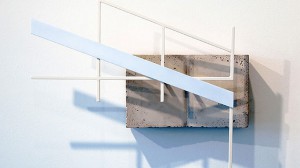Jonathan Runcio is an artist apparently comfortable in any number of media. When I first encountered him in 2008, he was screen printing and spray painting architectural patterns on plexi-glass, which he then bent into angular sculptures that mirrored the surface graphics — geometric paintings twisted into geometric sculptures. Next he began making delicate, floating wooden structures painted silver and so refined, their seams so well hidden, they looked like welded metal. Then concrete blocks turned up, their sides impossibly stenciled with these same patterns, and inevitably blueprints appeared.
Why inevitably? Because Runcio’s subject is the built environment. He is a “street” artist. Visit San Francisco’s Romer Young Gallery and see what appears to be a small, but ever-so-intentionally placed collection of seemingly minimalist sculptures. (They are actually postmodern collages.) Check out the accompanying riso print booklet, and you will see the inspiration for these shapes revealed. Untitled (Impression), the metallic sculpture that hangs in the middle of the room, is the copy of a pattern Runcio found embedded in the sidewalk. Other shapes come from inlays on garage doors or particular geometric confluences of gates or walkway railings. Runcio’s work is from the street and of the street, he employs stencils, spray paint, screen printing — all forms that appear in the public sphere for public address — to address the public spaces we encounter daily. He is awake to those lingering elements of modernist flourish that haunt the built environment. There is sculpture everywhere. Runcio appropriates it, bends it to his formidable will and re-presents it in an increasingly refined form, in what turns out to be an increasingly refined environment — the art gallery (but that’s a Bay Area-specific discussion for another day).

Jonathan Runcio, Untitled (Impression), 2013.
If you are at all familiar with Runcio’s process, you can be sure that he has already moved beyond the objects he is presenting today. The ideas behind the work are quickly evolving and, should he introduce a material we haven’t seen before — in Glass in the Garden the new substance is mirror (to further implicate the viewer’s place in space?) — you can rest assured that any rawness, any difficulty or lack of familiarity with the medium will have disappeared the next time you encounter it. Runcio’s facility with materials is intimidating.

Jonathan Runcio, Glass in the Garden installation shot, 2013.


